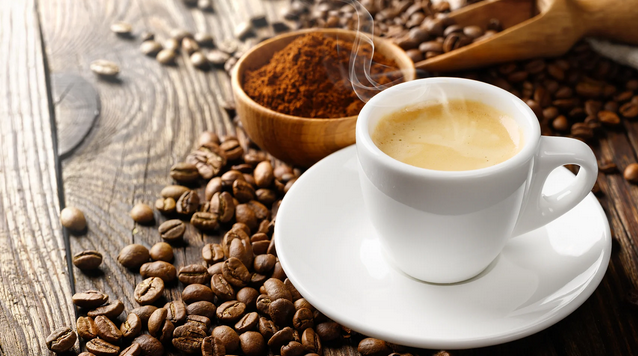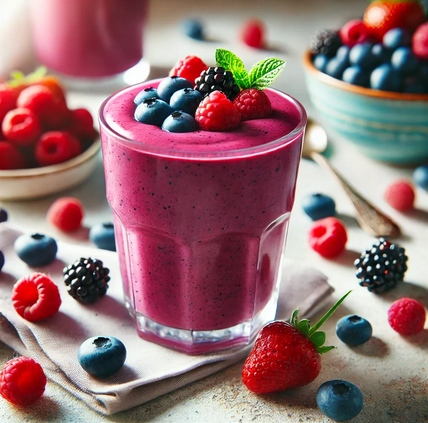The Art of Espresso: A Deep Dive into the World’s Most Iconic Coffee

There’s something magical about Espresso. It’s not just a drink; it’s an experience, a ritual, and a cornerstone of coffee culture worldwide. Whether you’re sipping it at a bustling Italian café or enjoying a quiet moment at home, Espresso has a way of captivating coffee lovers with its rich flavor, velvety texture, and intense aroma. But what exactly makes Espresso so special? Let’s explore the art, science, and history behind this beloved beverage.
What is Espresso?

The result is a small, potent shot of coffee topped with a layer of golden crema—a creamy foam that forms during the extraction process. Unlike drip coffee, which is brewed slowly, Espresso is made in a matter of seconds, capturing the essence of the coffee beans in a single, flavorful shot.
The History of Espresso
In 1901, Luigi Bezzera patented the first Espresso machine, designed to brew coffee quickly for busy customers. The machine used steam pressure to force water through coffee grounds, reducing brewing time from minutes to seconds. Over the years, Espresso machines evolved, and by the mid-20th century, they became a staple in Italian cafés. Today, Espresso is enjoyed worldwide, but its heart and soul remain deeply rooted in Italian culture.
What Makes a Perfect Espresso?

Here are the key elements that contribute to a great shot:
- Quality Beans: The foundation of any great espresso is high-quality coffee beans. Look for freshly roasted beans with a flavor profile that suits your taste—whether it’s fruity, nutty, or chocolatey.
- Grind Size: Espresso requires a fine, consistent grind. Too coarse, and the water will flow too quickly, resulting in a weak shot.
- Water Temperature: between 195°F and 205°F (90°C to 96°C). Too hot, and the coffee will taste burnt; too cool, and it will be under-extracted.
- Pressure: Espresso machines use 9 to 10 bars of pressure to extract the coffee. This high pressure is what creates the signature crema and concentrated flavor.
- Brew Time: A standard shot of espresso takes about 25 to 30 seconds to brew. Timing is crucial—too short, and the shot will be sour; too long, and it will be bitter.
- The Barista’s Touch: Even with the best equipment, the skill of the barista plays a huge role. From tamping the coffee grounds to monitoring the extraction, every step requires precision and care.
Espresso-Based Drinks: A World of Possibilities
One of the reasons Espresso is so beloved is its versatility. It serves as the base for a wide range of popular coffee drinks, including:
- Latte: A shot of Espresso with more steamed milk and a thin layer of foam.
- Americano: Espresso diluted with hot water, resembling drip coffee.
- Macchiato: Espresso “stained” with a small amount of steamed milk or foam.
- Flat White: Similar to a latte but with a higher ratio of Espresso to milk and a velvety micro foam.
Each drink offers a unique way to enjoy Espresso, catering to different tastes and preferences.
Why Espresso is More Than Just Coffee

Espresso is more than just a caffeine boost—it’s a symbol of connection and community. In Italy, Espresso is often enjoyed standing at a café counter, shared with friends or strangers. It’s a moment to pause, savor, and appreciate the simple pleasures of life. For many, the ritual of making or drinking Espresso is a daily act of self-care, a small indulgence that brings joy and comfort.
Tips for Making Espresso at Home
If you’re inspired to try making Espresso at home, here are a few tips to get started:
- Invest in a Good Machine: While you don’t need a professional-grade machine, a quality Espresso maker can make a big difference.
- Use Fresh Beans: Grind your beans just before brewing for the best flavor.
- Practice Your Technique: Tamping, dosing, and timing all take practice. Don’t be discouraged if your first few shots aren’t perfect.
- Experiment: Try different beans, grind sizes, and brew times to find your ideal Espresso.
The Espresso Lifestyle: Embracing the Ritual and Culture
Espresso isn’t just a drink—it’s a lifestyle. For many, it’s a daily ritual that sets the tone for the day, a moment of calm in the chaos, or a way to connect with others. The culture surrounding Espresso is rich and diverse, shaped by centuries of tradition and innovation. Let’s dive deeper into what makes Espresso such an integral part of life for so many people around the world.
The Ritual of Espresso
For coffee lovers, making and drinking Espresso is often a cherished ritual. From selecting the beans to grinding them, tamping the grounds, and watching the rich, dark liquid flow into the cup, every step is an opportunity to slow down and savor the moment. This ritual can be meditative, grounding, and deeply satisfying.
In Italy, the birthplace of Espresso, the ritual is often shared. Italians typically drink espresso quickly, standing at a café counter, often while chatting with the barista or other patrons. It’s a social experience, a moment of connection in the midst of a busy day. This tradition has spread around the world, with Espresso bars becoming hubs of community and conversation.
Espresso Around the World
While Espresso has its roots in Italy, it has been embraced and adapted by cultures worldwide. Each region has put its own spin on Espresso, creating unique drinks and traditions:
- Italy: The home of Espresso, where it’s often enjoyed as a quick, intense shot, sometimes with a twist of lemon or a sprinkle of sugar.
- France: In France, Espresso is often served with a small glass of water to cleanse the palate.
- Spain: Here, Espresso is the base for café con leche, a popular breakfast drink made with equal parts espresso and steamed milk.
- Australia: Known for its vibrant coffee culture, Australia has perfected the flat white, a creamy Espresso-based drink with velvety microfoam.
- United States: In the U.S., Espresso is the foundation of countless specialty drinks, from lattes to macchiatos, often customized with syrups, alternative milks, and toppings.
No matter where you go, Espresso serves as a universal language, bringing people together over a shared love of coffee.
The Science of Flavor
What makes Espresso taste so unique? The answer lies in the science of extraction. When hot water is forced through finely-ground coffee under high pressure, it extracts a complex blend of flavors, oils, and aromas. The result is a concentrated shot that captures the essence of the coffee beans.
The flavor profile of Espresso can vary widely depending on factors like the bean origin, roast level, grind size, and brewing technique. A well-pulled shot of Espresso should strike a balance between sweetness, acidity, and bitterness, with notes of chocolate, caramel, fruit, or nuts, depending on the beans used.
The crema—the golden foam that forms on top of a shot of Espresso—is also a key indicator of quality. A thick, velvety crema is a sign of a well-extracted shot, while a thin or nonexistent crema may indicate issues with the grind, tamp, or machine.
Espresso and Creativity
Espresso is not just a drink; it’s a canvas for creativity. Baristas and coffee enthusiasts around the world are constantly experimenting with new ways to enjoy and present Espresso. From latte art to innovative brewing methods, the possibilities are endless.
- Latte Art: The practice of pouring steamed milk into Espresso to create intricate designs, from hearts and rosettas to more elaborate patterns.
- Alternative Brewing Methods: While traditional Espresso machines are the most common way to make Espresso, alternative methods like the AeroPress or Moka pot can also produce Espresso-like results.
- Flavor Pairings: Espresso pairs beautifully with a variety of flavors, from sweet pastries to savory dishes. Try pairing a shot of Espresso with dark chocolate, almond biscotti, or a slice of tiramisu for a truly indulgent experience.
The Health Benefits of Espresso
In addition to its rich flavor and cultural significance, Espresso also offers a range of health benefits when consumed in moderation:
- Antioxidants: Espresso is packed with antioxidants, which help protect the body from free radicals and reduce inflammation.
- Improved Focus: The caffeine in Espresso can enhance mental clarity, focus, and alertness.
- Boosted Metabolism: Caffeine has been shown to increase metabolic rate, aiding in weight management.
- Lower Risk of Certain Diseases: Studies suggest that moderate coffee consumption may reduce the risk of conditions like Parkinson’s disease, Alzheimer’s disease, and type 2 diabetes.
Of course, it’s important to enjoy Espresso in moderation and be mindful of your caffeine intake, especially if you’re sensitive to its effects.
Espresso at Home: Tips for Mastery
Making Espresso at home can be a rewarding experience, but it does require some practice and patience. Here are a few additional tips to help you master the art of home Espresso:
- Keep Your Equipment Clean: Regularly clean your Espresso machine and grinder to ensure optimal performance and flavor.
- Experiment with Ratios: The standard espresso shot uses a 1:2 ratio of coffee to water (e.g., 18 grams of coffee to 36 grams of water), but you can adjust this to suit your taste.
- Preheat Your Equipment: Make sure your portafilter and cup are preheated to maintain the temperature of your Espresso.
- Track Your Progress: Keep a journal of your brewing experiments, noting variables like grind size, dose, and brew time.
- Don’t Be Afraid to Ask for Help: If you’re struggling to get the perfect shot, don’t hesitate to seek advice from experienced baristas or online coffee communities.
Espresso: A Timeless Classic
In a world of ever-changing food and drink trends, Espresso remains a timeless classic.
Its rich history, complex flavor, and cultural significance make it a beverage that transcends borders and generations.
Final Thoughts
Espresso is more than just a drink—it’s a celebration of craftsmanship, culture, and flavor. Whether you’re a seasoned coffee enthusiast or a curious beginner, there’s always something new to discover in the world of Espresso. So the next time you take a sip, take a moment to appreciate the artistry and passion that went into creating that perfect shot. Cheers to the magic of Espresso! ☕


